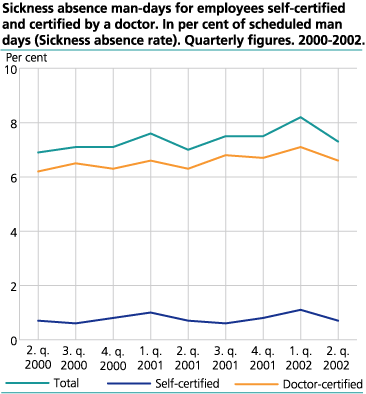Content
Published:
This is an archived release.
No change in self-certified sickness absences
The total sickness absence rate was 7.2 per cent in the 2n d quarter 2002, of which 0.7 per cent were self-certified and 6.6 doctor-certified absences. The self-certified absence rate has been unchanged 2n d quarter the last two years.
Measured in per cent of scheduled man-days, the self-certified sickness absence was 0.7 per cent both in 2n d quarter 2001 and the 2n d quarter 2002. The total absences rate increased from 7.0 per cent in the 2n d quarter 2001 to 7.2 per cent in the 2n d quarter 2002. The annual increase of 0.3 percentage points corresponds to an annual growth of 3.7 per cent. This statistics cover all employees 16-69 years of age.
Health and social work highest self-certified sickness absence
The self-certified sickness absence varies less between industries than the sickness absence certified by a doctor. The section health and social work had the highest self-certified sickness absence, with an absence rate of 0.9 per cent in the 2n d quarter 2002, followed by the section Manufacturing and mining with 0.8 per cent.
Women have higher sickness absence
Compared with men, women both have higher self-certified sickness absence (0.8 vs. 0.6 per cent) and sickness absence certified by a doctor (8.2 vs. 5.3 per cent). Sickness absence regarding pregnancy may explain some of the differences in sickness absence certified by a doctor.
Increased maximum period of self-certification
Lately many enterprises have opened for a change in the maximum period of self-certified sickness absence from 3 to 8 consecutive calendar days. A transfer of sickness absence from doctor-certified to self-certified sickness absence may be the result. No noticeable changes in the figures have been reported so far.
Due to shorter time of production, doctor-certified sickness absences statistics for the 3r d quarter 2002 are also published December the 11t h, with more details, on our web site: http://www.ssb.no/sykefra_en/ .
The sickness absence statistics are produced in cooperation with the National Insurance Administration (RTV).
Tables:
- Table 1 Sickness absence man-days for employees self-certified and certified by a doctor. In per cent of scheduled man-days (Sickness absence rate). Quarterly figures. 2000-2002
- Table 2 Sickness absence man-days for employees self-certified and certified by a doctor, by sex. In per cent of scheduled man-days (Sickness absence rate). Quarterly figures. 2000-2002
- Table 3 Sickness absence man-days for employees self-certified and certified by a doctor, by industry and type of sickness absence. In per cent of scheduled man days (Sickness absence rate). Quarterly figures. 2000-2002
Contact
-
Arbeidsmarked og lønn
E-mail: arbeidsmarked@ssb.no
-
Unn H. Høydahl
E-mail: unnh.hoydahl@ssb.no
tel.: (+47) 40 90 23 77

